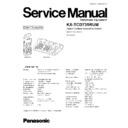Panasonic KX-TCD735RUM Service Manual ▷ View online
6.2.9.
POWER SUPPLIES (SEE Fig. 20)
The AC adaptor for the KX-TCD735 provides unregulated DC through J2 for the handset charge terminal, 6V regulator (IC1)
the 3.8V regulator (IC7) and the Relay coil (RL1) where fitted.
the 3.8V regulator (IC7) and the Relay coil (RL1) where fitted.
The 3.8V supply from IC7 is used for the RF module, and is further reduced by IC11 to 2.7V for the BBIC supply.
The 6V supply from IC1 is used for SP-Phone AMP. (IC14).
R17, 18 and 28 provide short circuit/over current protection at the handset charge terminal.
R109, D6, T1, R110, R111, R112 and D11 are charge detection circuit, in order to detect whether put Handset on cradle or not.
Fig. 20
21
KX-TCD735RUM
6.3.
Speakerphone (SEE Fig. 21)
The extra circuitry for the TCD735 speakerphone circuit comprises a microphone, a speaker, and a speaker amplifier IC14.
However, note that the majority ofthe speakerphone functionality is contained within the existing BBIC IC6. This includes the
switching between microphone and speaker path, echo suppression and cancelling, etc.
However, note that the majority ofthe speakerphone functionality is contained within the existing BBIC IC6. This includes the
switching between microphone and speaker path, echo suppression and cancelling, etc.
Around circuit ofT14 is filter in order to reduce sampling noise.
The DC supply to the speakerphone amplifier IC14 pin 6, is a 6V supply, derived from the regulator IC1 (TP220).
Fig. 21
22
KX-TCD735RUM
6.3.1.
Path from Telephone Line to Speaker
Audio from the telephone line passes via the normal signal path of J1 tel-line connector (TP26 and TP40), D8 bridge rectifier, T8
hookswitch (TP50), and R41, to BBIC IC6 pin 133. In the BBIC it is converted from an analogue audio signal into digital data in the
BBIC´s internal codec. Additionally, the speakerphone switching and echo suppression functions are contained within the BBIC. An
eight level speaker volume control is provided, and the functionality for this is also contained within the BBIC. The analog data is
sent from the BBIC IC6 pin 113 to the speaker amplifier IC14 pin 4, via filter circuit (T14). The audio signal is amplified in IC14, and
the push-pull audio output is sent from IC14 pins 5 and 8 to the speaker (TP9) and (TP10).
hookswitch (TP50), and R41, to BBIC IC6 pin 133. In the BBIC it is converted from an analogue audio signal into digital data in the
BBIC´s internal codec. Additionally, the speakerphone switching and echo suppression functions are contained within the BBIC. An
eight level speaker volume control is provided, and the functionality for this is also contained within the BBIC. The analog data is
sent from the BBIC IC6 pin 113 to the speaker amplifier IC14 pin 4, via filter circuit (T14). The audio signal is amplified in IC14, and
the push-pull audio output is sent from IC14 pins 5 and 8 to the speaker (TP9) and (TP10).
6.3.2.
Path from Microphone to Telephone Line
DC bias for the microphone is provided from the BBIC IC6 pin 118 (positive bias) and GND (negative bias). The bias is fed to the
microphone via R15 and R23 (positive bias) and R12 (negative bias). The balanced audio signal from the microphone is fed to the
BBIC (IC6), via R77, C71 and R2 (Positive), R78, C72 and R71 (negative).
microphone via R15 and R23 (positive bias) and R12 (negative bias). The balanced audio signal from the microphone is fed to the
BBIC (IC6), via R77, C71 and R2 (Positive), R78, C72 and R71 (negative).
The analogue signal is converted into a digital signal in the BBIC IC6 pin 119 and 122. The speakerphone switching and echo
suppression functions are contained within the BBIC. The digital data is converted again into an analogue signal in the BBIC´s
internal codec.
suppression functions are contained within the BBIC. The digital data is converted again into an analogue signal in the BBIC´s
internal codec.
The analogue signal is fed from IC6 pin126, via T13 audio amplifier, T8 hookswitch (TP50), D8 bridge rectifier, to J1 tel. line
connector (TP26 and TP40), and out to the telephone line.
connector (TP26 and TP40), and out to the telephone line.
6.4.
Keyboard
The TCD735 is fitted with a keyboard which provides the user with comprehensive speakerphone and TAM facilities, and includes
a full numeric keypad for dialling out.The keyboard is mounted on a separate pcb, and is connected to the main pcb via J3
connector.
a full numeric keypad for dialling out.The keyboard is mounted on a separate pcb, and is connected to the main pcb via J3
connector.
Keyboard scan pulses and LED drive signals are fed from the BBIC address/data bus to the keyboard via and connector J3.Key
press information from the keyboard is fed via J3 to the BBIC address/data bus.
press information from the keyboard is fed via J3 to the BBIC address/data bus.
LCD is connected to keyboard via J2 (LCD connector), and it is controled by BBIC (IC6).
23
KX-TCD735RUM
6.5.
RFMODULE
BLOCK DIAGRAM RFMODULE
Fig. 22
6.5.1.
RFMODULE (SEE BLOCK DIAGRAM Fig. 22)
The RF Module consists oftwo main components: the PMB6610 transceiver and the PMB6818 power amp.
In the transceiver the 10.368MHz clock signal SYCL is multiplied to around 1.9GHz using PLL (Phase Locked Loop) control.
The TXDA signal is used to control the modulation ofthis frequency to 1.87GHz to 1.93GHz.
Received signals are demodulated, filtered and sent to the BBIC via the RXDA line.
The RSSI (Radio Signal Strength Indicator) signal enables the implementation ofdiversity switching whereby two antennae can
be mounted in different orientations and their signals compared. The one with better reception can be selected by the BBIC
using the ANT1 and ANT2 lines.
be mounted in different orientations and their signals compared. The one with better reception can be selected by the BBIC
using the ANT1 and ANT2 lines.
24
KX-TCD735RUM
Click on the first or last page to see other KX-TCD735RUM service manuals if exist.

